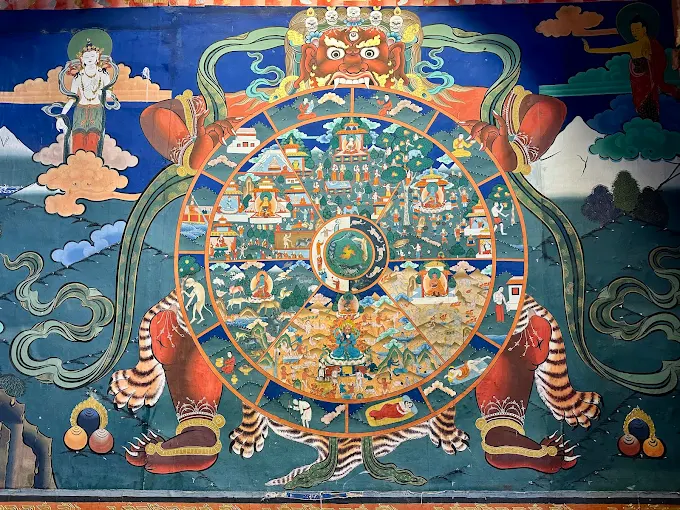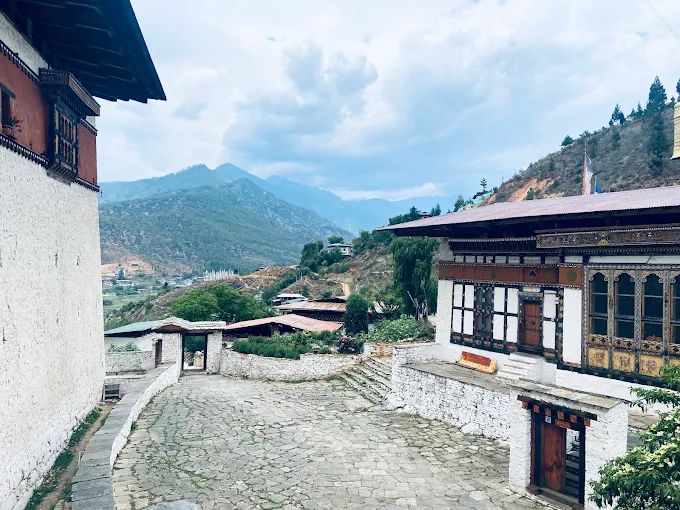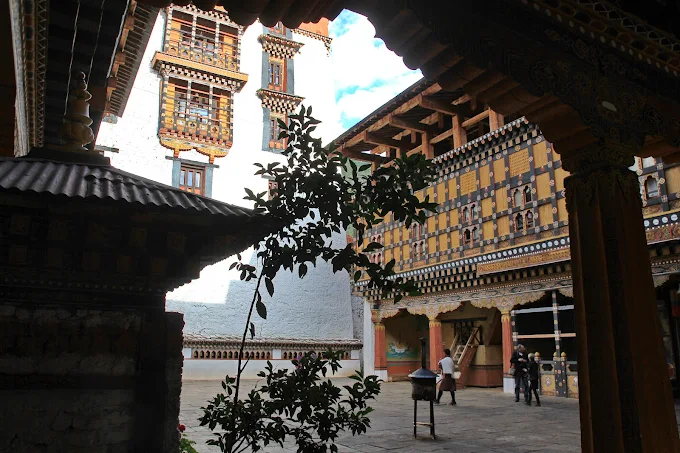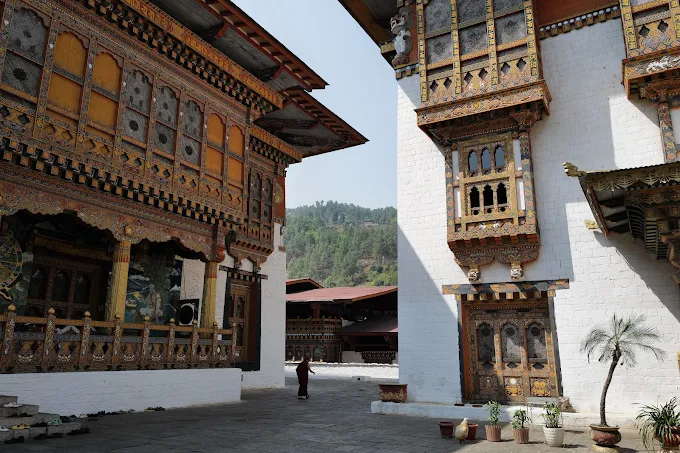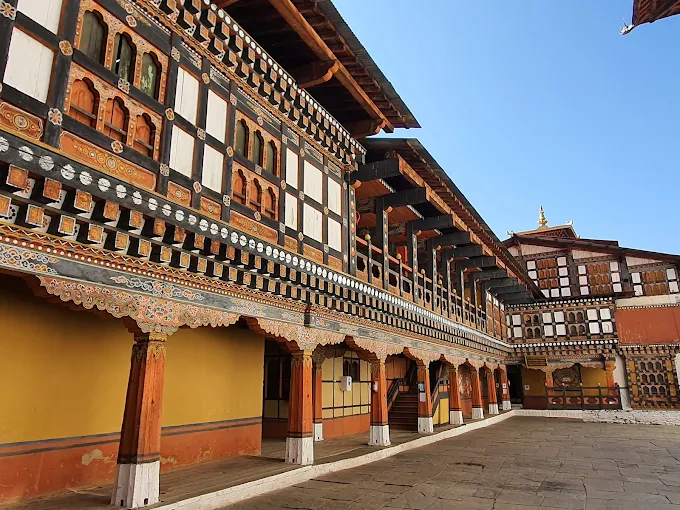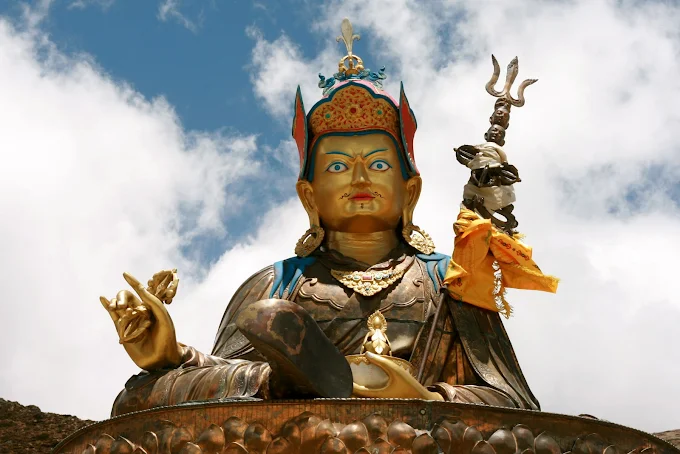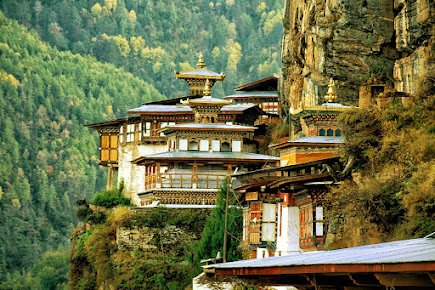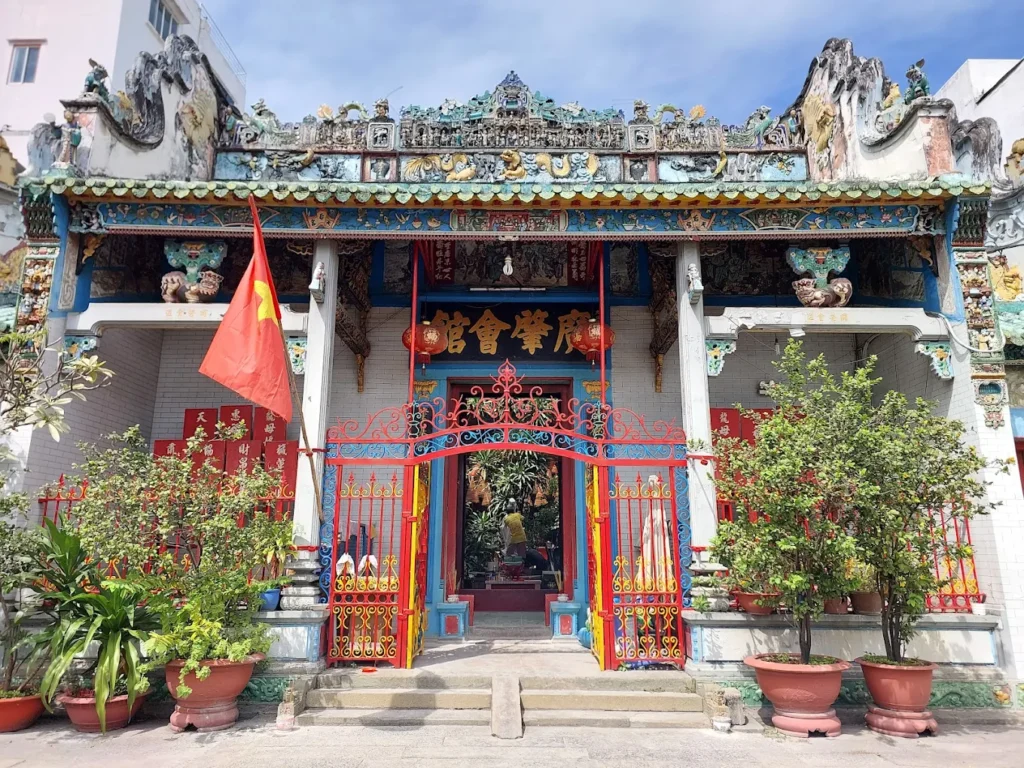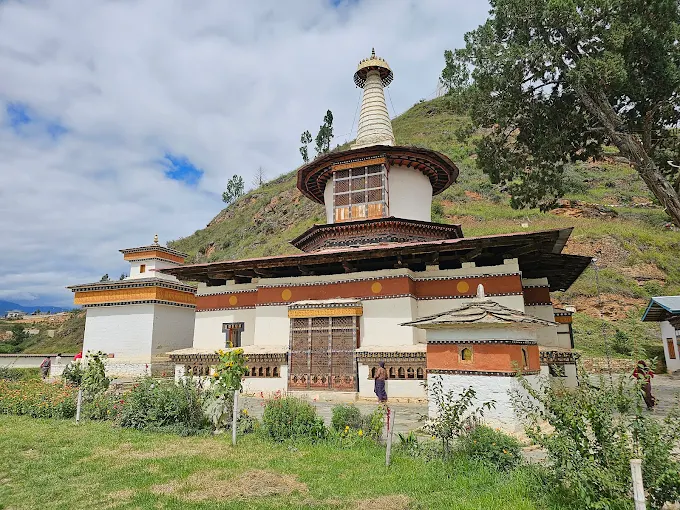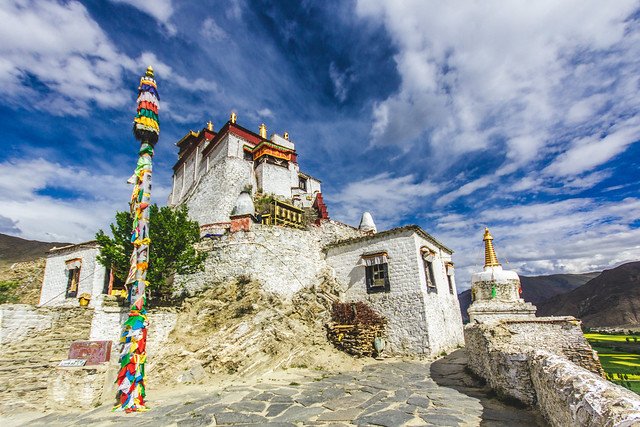Rinpung Dzong: The Fortress of Sacred Might
Overview and Significance
Essence of Rinpung Dzong
Rinpung Dzong, known as the “Fortress on a Heap of Jewels,” stands majestically above the Paro Valley in Bhutan, its towering whitewashed walls and golden roofs exuding both spiritual and temporal authority. Built in 1644, this dzong (fortress-monastery) blends the roles of a religious sanctuary and administrative stronghold, embodying Bhutan’s unique fusion of faith and governance. Its imposing presence along the Paro Chhu river draws pilgrims, officials, and travelers, who are captivated by its grandeur and the vibrant Paro Tshechu festival it hosts. Rinpung Dzong is not just a structure but a living symbol of Bhutan’s cultural resilience and spiritual depth.
- Defining Trait: A fortress-monastery hosting the vibrant Paro Tshechu festival.
- Spiritual Role: A sacred hub for Buddhist practice and royal ceremonies.
- Visitor Appeal: A must-see for its architecture and cultural festivities.
The dzong’s sprawling courtyards, adorned with prayer flags and ancient murals, pulse with life during festivals, yet offer serene corners for quiet reflection. Its strategic location, overlooking the valley, reflects its historical role as a defensive bastion, while its sacred shrines honor Guru Rinpoche and other deities. For Bhutanese, Rinpung is a source of pride; for visitors, it’s a window into a kingdom where tradition thrives.
Historical Evolution
Rinpung Dzong was commissioned in 1644 by Zhabdrung Ngawang Namgyal, the unifier of Bhutan, to consolidate spiritual and political power in the Paro Valley. Built on the site of a smaller monastery, it became a model for Bhutan’s dzong architecture, blending defense with devotion. Over centuries, it withstood invasions and natural disasters, including a 1907 earthquake, with renovations preserving its original design. Royal patronage and monastic stewardship have ensured its enduring prominence.
- Key Milestones:
- 1644: Zhabdrung Ngawang Namgyal constructs Rinpung Dzong.
- 1907: Earthquake damages the dzong, followed by extensive repairs.
- 1960s: Modernization adds administrative offices while preserving sacred spaces.
- Ongoing: Monks and artisans maintain its spiritual and structural integrity.
Unlike many Himalayan fortresses, Rinpung has never fallen to invaders, a fact locals attribute to divine protection. Renovations, often funded by Bhutan’s monarchy, use traditional materials like rammed earth and timber, honoring Zhabdrung’s vision. A legend tells of a hidden relic, placed by Zhabdrung in the central tower, safeguarding the dzong from harm. Today, Rinpung remains a vital center, housing both monks and district officials.
Cultural Impact
Rinpung Dzong is a cultural cornerstone, anchoring Bhutan’s Buddhist heritage and national identity. It hosts the Paro Tshechu, a five-day festival honoring Guru Rinpoche, where masked dances and sacred rituals draw thousands, reinforcing community bonds. As an administrative seat, it bridges Bhutan’s spiritual and secular realms, symbolizing the nation’s Gross National Happiness philosophy.
- Local Role: A pilgrimage and festival hub uniting Paro’s communities.
- National Symbol: Embodies Bhutan’s blend of faith and governance.
- Global Influence: Attracts scholars and tourists studying Bhutanese culture.
Globally, Rinpung captivates for its architectural splendor and vibrant festivals, featured in travel media and documentaries. Its role in Bhutan’s governance fascinates political researchers, while its Buddhist practices draw practitioners of Vajrayana Buddhism. Bhutan’s regulated tourism ensures Rinpung remains a living site, its cultural significance undiluted by mass visitation.
Signature Legacy
Rinpung Dzong’s legacy is tied to the Paro Tshechu, particularly the unveiling of the Guru Thongdrel, a massive thangka (scroll painting) depicting Guru Rinpoche. Displayed on the festival’s final day, this sacred textile, believed to grant blessings, draws pilgrims who queue before dawn to pass beneath it. The dzong’s central tower, Utse, is said to house Zhabdrung’s relics, cementing its spiritual potency.
- Festival Allure: The Guru Thongdrel’s unveiling is a spiritual highlight.
- Sacred Relics: Utse tower holds Zhabdrung’s protective artifacts.
- Local Tales: Stories of blessings received under the thangka abound.
Anecdotes tell of pilgrims healed or enlightened after viewing the Thongdrel, with one elder claiming a vision of Guru Rinpoche during the ceremony. These stories, shared across generations, make Rinpung a place of miracles, its legacy woven into Bhutan’s festive and spiritual life.
Community and Global Reach
Rinpung binds Paro’s communities, with locals donating rice and butter for festivals and monks guiding rituals. The dzong’s administrative role employs dozens, from clerks to archivists, integrating it into daily life. Globally, it attracts Buddhist pilgrims from Tibet, India, and beyond, as well as tourists drawn to its Tshechu and architecture.
- Community Engagement: Locals support festivals and upkeep.
- Monastic Role: Monks lead rituals and preserve sacred texts.
- Global Visitors: Draws Buddhists, scholars, and cultural enthusiasts.
Bhutan’s diaspora honors Rinpung through festival remittances, while international conservationists advocate for its preservation, eyeing UNESCO recognition. Travel platforms amplify its fame, yet Bhutan limits visitors to protect its sanctity, ensuring Rinpung remains a vibrant, sacred space.
Architectural Features
Distinctive Design
Rinpung Dzong’s architecture is a masterpiece of Bhutanese dzong design, its massive rammed-earth walls and timber framework exuding strength and elegance. Perched above the Paro Chhu, its five-story structure, topped by the Utse tower, commands the valley, blending defensive utility with spiritual symbolism. The dzong’s whitewashed exterior, accented with red and gold, reflects Bhutan’s aesthetic of purity and divinity. Its sprawling layout, with multiple courtyards and shrines, balances monastic seclusion with administrative bustle.
- Fortress Aesthetic: Thick walls and strategic placement ensure defense.
- Color Symbolism: White, red, and gold evoke spiritual ideals.
- Functional Layout: Separates sacred and secular spaces seamlessly.
The dzong’s entrance, accessed via a covered wooden bridge, sets a dramatic tone, with prayer wheels lining the path. Courtyards, paved with stone, host festivals, while narrow passages lead to quiet shrines. Rinpung’s design, rooted in Zhabdrung’s vision, remains a blueprint for Bhutan’s other dzongs, its grandeur tempered by spiritual purpose.
Signature Structures
The Utse tower, the dzong’s spiritual and architectural core, houses sacred relics and a shrine to Guru Rinpoche, its elevated position symbolizing divine authority. The main temple, Lhakhang, contains statues of Sakyamuni Buddha and Zhabdrung, their gilded surfaces glowing by lamplight. The festival courtyard, framed by balconied galleries, transforms during Tshechu, hosting dances and the Thongdrel’s display.
- Utse Tower: Central shrine, believed to hold Zhabdrung’s relics.
- Lhakhang: Main temple with revered Buddha and Zhabdrung statues.
- Festival Courtyard: A vibrant stage for Tshechu rituals.
A monastic dormitory, tucked behind the Lhakhang, shelters monks, its simple design contrasting the dzong’s grandeur. The administrative wing, with carved wooden offices, reflects Rinpung’s dual role. Each structure, from the bridge to the tower, harmonizes function and faith, creating a cohesive, awe-inspiring complex.
Artisanal Mastery
Rinpung’s craftsmanship showcases Bhutan’s artistic heritage. Murals in the Lhakhang, painted with mineral pigments, depict the Buddha’s life and Tantric deities, their vibrant reds and blues enduring centuries. Thangkas, used during Tshechu, feature silk-embroidered images of Guru Rinpoche, crafted by Paro’s artisans. Wooden balconies, carved with cloud and lotus motifs, highlight Himalayan woodworking skills.
- Murals: Vivid narratives, using natural pigments.
- Thangkas: Intricate textiles for ritual display.
- Woodwork: Carvings symbolize cosmic order.
Restoration efforts, like those post-1907, rely on traditional techniques, with artisans hand-mixing pigments and sourcing local timber. The Thongdrel, a massive appliqué thangka, requires months of communal labor, its creation a devotional act. These crafts, passed through generations, ensure Rinpung’s visual splendor remains vibrant.
Hidden Architectural Gems
Rinpung’s subtler features enchant the observant. A small shrine to local deities, tucked near the entrance, draws villagers’ offerings, its faded murals hinting at ancient rituals. Prayer wheels, embedded in courtyard walls, spin with a soft hum, their bronze surfaces polished by pilgrims. A rooftop terrace, accessible to monks, offers panoramic valley views, its solitude a hidden retreat.
- Local Shrine: Honors Paro’s protective spirits.
- Prayer Wheels: Tactile links to Buddhist practice.
- Rooftop Terrace: A monks’ sanctuary with sweeping views.
These elements, often overlooked, enrich Rinpung’s character. The shrine’s intimacy contrasts the dzong’s scale, while the prayer wheels’ rhythm soothes. The terrace, though off-limits to visitors, adds mystique, its existence whispered in guides’ tales.
Preservation and Evolution
Preserving Rinpung is a complex task, given its age and environmental challenges. Post-1907 repairs reinforced walls with stone, countering earthquake risks. Artisans train in traditional mural techniques, using Himalayan minerals for pigments. Monsoons threaten timber beams, requiring regular maintenance funded by Bhutan’s government.
- Post-Earthquake Repairs: Strengthened foundations with stone.
- Artisan Training: Preserves mural and woodwork skills.
- Environmental Challenges: Monsoons and cold test materials.
Modern upgrades, like discreet fireproofing, reduce risks from butter lamps, while solar panels power minimal lighting. Bhutan’s conservation efforts, backed by international grants, ensure Rinpung’s integrity, balancing its roles as a fortress, monastery, and cultural treasure.
Rituals and Practices
Sacred Daily Rites
Each morning, Rinpung’s monks gather in the Lhakhang, chanting mantras as butter lamps illuminate the Buddha’s statue. The air fills with incense, its earthy scent mingling with the soft thud of prayer beads. Monks offer water bowls, their delicate placement a daily act of purification, setting a reverent tone.
- Morning Chants: Recite texts like the Guru Mantra.
- Butter Lamps: Symbolize wisdom dispelling ignorance.
- Offerings: Water bowls purify sacred spaces.
The rituals’ cadence, echoing through stone courtyards, creates an immersive atmosphere. Visitors, though barred from inner shrines, sense the devotion through open doors, where monks’ red robes flash against gilded altars. Rinpung’s daily rites, though simple, anchor its spiritual life.
Unique Spiritual Practices
Rinpung’s practices revolve around Guru Rinpoche and Zhabdrung. Pilgrims circumambulate the Utse tower, spinning prayer wheels to accrue merit. During special rituals, monks consecrate khatas, which devotees offer to statues, seeking blessings. A rare practice involves blessing sacred cords, worn for protection, believed to carry the dzong’s divine energy.
- Circumambulation: A meditative walk around the Utse.
- Khata Offerings: Silk scarves symbolize devotion.
- Sacred Cords: Blessed for pilgrims’ protection.
These practices, rooted in Vajrayana Buddhism, foster a deep connection to Rinpung’s founders. The cords, tied with intricate knots, are prized by locals, who attribute healings to their power. For devotees, these acts make Rinpung a conduit to the divine.
Vibrant Festival Traditions
The Paro Tshechu, held in spring, transforms Rinpung into a vibrant stage. Monks perform cham dances, their masked figures reenacting Guru Rinpoche’s triumphs, accompanied by drums and cymbals. The Guru Thongdrel’s unveiling, on the final day, draws thousands, who pass beneath it for blessings, believing it cleanses sins.
- Cham Dances: Masked performances of spiritual narratives.
- Thongdrel Unveiling: A sacred moment granting blessings.
- Community Role: Unites locals in celebration.
Smaller festivals, like Zhabdrung’s memorial day, see quieter rites, with monks offering torma (dough figures). Visitors during Tshechu experience Rinpung’s dual nature: a solemn monastery and a communal heart. The dances’ vivid colors and rhythmic energy create lasting memories.
Visitor Engagement
Visitors can participate in limited rituals, deepening their experience. Lighting butter lamps, available for donations, allows tourists to join locals in prayer. Spinning prayer wheels offers a tactile connection to Buddhist practice, their hum soothing. Guides teach simple mantras, letting visitors chant during courtyard walks.
- Butter Lamps: An accessible devotional act.
- Prayer Wheels: Spinning accrues merit.
- Mantra Chanting: Enhances spiritual engagement.
These acts bridge cultural gaps, letting outsiders feel Rinpung’s pulse. Photography inside shrines is banned, but courtyard shots are allowed, capturing dancers or prayer flags. The Tshechu, if timed right, offers a chance to witness Bhutan’s living traditions up close.
Monastic and Community Roles
Rinpung’s monks, numbering around 100, lead rituals, study texts, and mentor novices. They bless amulets, sold in Paro’s markets, which locals wear for luck. The community supports the dzong, donating food and labor during Tshechu, seeing it as a sacred duty.
- Monastic Duties: Chanting, teaching, and shrine upkeep.
- Community Support: Sustains Rinpung’s vitality.
- Cultural Continuity: Preserves Bhutanese traditions.
During festivals, monks lead processions, linking Rinpung to nearby villages. Locals, from farmers to officials, participate, their involvement ensuring Rinpung’s role as a cultural and spiritual anchor endures.
Visitor Information
Navigating to Rinpung Dzong
Rinpung Dzong sits 2 km from Paro town, a 5-minute drive or 30-minute walk along the Paro Chhu. The iconic wooden bridge, cantilevered over the river, marks the entrance, flanked by prayer wheels. Landmarks include a chorten near the bridge and the dzong’s towering silhouette against the valley.
- Starting Point: Paro town, near the main square.
- Landmarks: Wooden bridge and riverside chorten.
- Route: A short, scenic drive or flat walk.
Taxis cost ~$3, or guided tours include Rinpung with other sites. Walking offers views of rice fields and traditional houses, enhancing the approach. Guides, mandatory for tourists, share stories of Zhabdrung, enriching the journey.
Address of Rinpung Dzong
Rinpung Dzong is located in Paro, Paro District, Bhutan, along the banks of the Paro Chhu river, accessible via the Paro-Chhuzom road. Its precise coordinates are approximately 27.4292°N, 89.4236°E. Visitors should coordinate with tour operators, as Bhutan requires guided visits for foreigners.
Visiting Hours and Etiquette
Rinpung is open daily from 8 AM to 5 PM, closing briefly from 1 PM to 2 PM for prayers. Morning visits (8-10 AM) avoid crowds, ideal for photos. Entry is included in Bhutan’s $100 daily tourist fee, with permits checked by guides.
- Hours: 8 AM–1 PM, 2 PM–5 PM; extended during Tshechu.
- Permits: Covered by tourist fee, arranged by operators.
- Best Time: Spring or autumn for clear skies and festivals.
Etiquette demands modest dress (long sleeves, no shorts), removing shoes in shrines, and avoiding pointing at statues. Speak softly and avoid interrupting monks’ rituals. Photography is allowed in courtyards but prohibited inside temples, respecting sanctity.
Accessibility and Safety
Rinpung’s flat courtyards are accessible, but steps to upper levels challenge mobility-impaired visitors. Wheelchair users may need assistance over uneven stones, with no ramps available. The low altitude (2,200 meters) poses minimal health risks.
- Mobility: Flat areas, but steps limit full access.
- Health: Low altitude, no acclimatization needed.
- Safety: Safe, but watch for slippery stones in rain.
Monsoons (June-August) can make paths slick, so wear sturdy shoes. Guides carry first-aid kits, and Paro’s clinic is 10 minutes away. Stay with your group, as solo exploration is restricted.
Amenities and Surroundings
Rinpung has no on-site facilities, but Paro town, 2 km away, offers hotels, restaurants, and restrooms. A riverside stall sells water and snacks. The valley’s rice paddies, Himalayan peaks, and prayer flags create a serene backdrop, the air crisp with river mist.
- Nearby Amenities: Paro’s eateries serve local dishes like ema datshi.
- On-Site: Basic stall for drinks and snacks.
- Sensory Details: River’s murmur, prayer flags’ flutter, pine-scented breeze.
Paro’s markets sell handicrafts and amulets, perfect souvenirs. Evening walks along the river reveal starlit skies, complementing Rinpung’s majesty. The dzong’s gardens, with blooming flowers, offer a quiet spot to rest.
Immersive Visitor Tips
Visit during Tshechu to see cham dances, arriving early for prime courtyard views. Sketch the Utse tower from the bridge, capturing its form without indoor photography. Walk to Paro’s markets post-visit, browsing thangkas to extend the cultural experience. Pair Rinpung with Kyichu Lhakhang for a deeper dive into Paro’s heritage.
- Tshechu Timing: Catch dances and the Thongdrel unveiling.
- Sketching: Record the dzong’s silhouette meditatively.
- Market Stroll: Explore Paro’s handicrafts for souvenirs.
Engage guides for Tshechu legends, adding depth to the visit. Wear layers for cool mornings, and carry a journal to note impressions. These touches transform Rinpung into a personal journey, blending history, faith, and Bhutan’s vibrant traditions.
